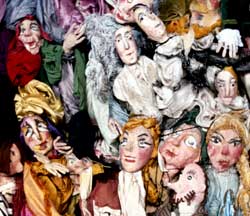
 Collezione
Maria Signorelli
Collezione
Maria Signorelli
Italian rod and glove puppets of the 19th and 20th centuries
The
Puppets of Maria Signorelli
The fairy tales, nursery rhymes and films
Shows with classical and modern texts, films
The ballets of Maria Signorelli
19th-20th century Italian rod and glove puppets
19th-20th century Italian marionettes
20th century foreign rod and string puppets
Sicilian, Pugliese and Neapolitan puppets
Toy
rod, glove and string puppets
Paper
and card theatres, sets and characters
Scripts
of puppet and marionette plays
Posters
of puppet theatre productions and festivals
It is generally known that puppet theatres have existed from the sixteenth century on, but their enormous popularity in the nineteenth century is also recorded by a considerable amount of evidence, both visual (for example, Bartolomeo Pinelli’s lithographs and Dura’s coloured engravings) and literary (from D’Azeglio to Belli, Stendhal, Andersen and Gregorovius, to name just a few).
Unlike marionette, or string puppet, theatre, rod or glove puppet theatre was popular on a broader front, and performed in public piazzas where the so-called ‘baracca’ (booth) or ‘casotto’ (hut) for the puppets was set up.
This
theatre often drew on the plots of the commedia dell’arte, and the possibility for improvising allowed the best puppeteers to
pass on through their shows news gathered in various places, and indeed at times to criticise political and military institutions. It
was not for nothing that a satirical newspaper founded in Rome around the middle of the
nineteenth century was called Il Casotto dei burattini (The puppet booth), with as its motto: ‘If you don’t like it you can
leave.’
In the Signorelli Collection there are at least a hundred and fifty items of varied provenance, between 50 and 60cm tall, with finely carved wooden hands and heads, some with glass eyes, and with richly decorated headgear and costumes; there are also others of simpler make.
Around thirty puppets by the Bolognese Emilio Frabboni (1880-1952) stand out, with splendid heads and very well preserved costumes: these are of many characters from traditional commedia dell’arte, such as Fagiolino, Balanzone, Brighella and Sganapino.
Of special interest too are various items (with little curtains and handbills belonging to the great family of puppeteers Campogalliani, who were active for around 200 years) and in particular to Ugo (1864-1943). But the beautiful Warrior of Emilio Preti (1845-1914) is also worthy of note, and from Modena a complete series of toy puppets (Sandrone, Fagiolino, Brighella, Tartaglia, Sganapino, Doctor Balanzone, the King, the Old Woman, the Young Man, Death, the Magician, the Devil and the Nobleman), all around 40cm tall, by the Bolognese Luciano Bettini, and intended for a child as first communion gift.
Several puppets have been preserved made by the Venetian Emilio Zago (1852-1929) remarkable for the extraordinary vivacity of the faces, in addition to costumes designed with historical accuracy and richness of detail.
One of the most valuable items is the Pulcinella (40cm), by Ghetanaccio (Gaetano Santangelo, 1782-1832), the most famous Roman puppeteer of the nineteenth century, who was thrown in prison several times because of his satires against the Papal government. His ‘casotto’, or hut, which he carried on his shoulders, was also painted by Pinelli, while some episodes of his life have been caustically recounted by, among others, the poets Belli and Zanazzo.
Maria Signorelli wrote a monograph on Ghetanaccio, published in 1960 by the Paduan firm Amicucci.
There are also various
xylographs in this section by Aristide Barilli depicting the puppets of Italo Ferrari (formerly belonging to Petrolini), as well as
curtains (such as that of a Bolognese puppet theatre painted in oils and representing four famous figures of commedia dell’arte,
160x113cm), playbills, nineteenth-century photographs of children at
performances in the piazza, old newspapers, photographs of historical puppet theatres or of works of great artists who have
immortalised scenes of this popular type of theatre.
